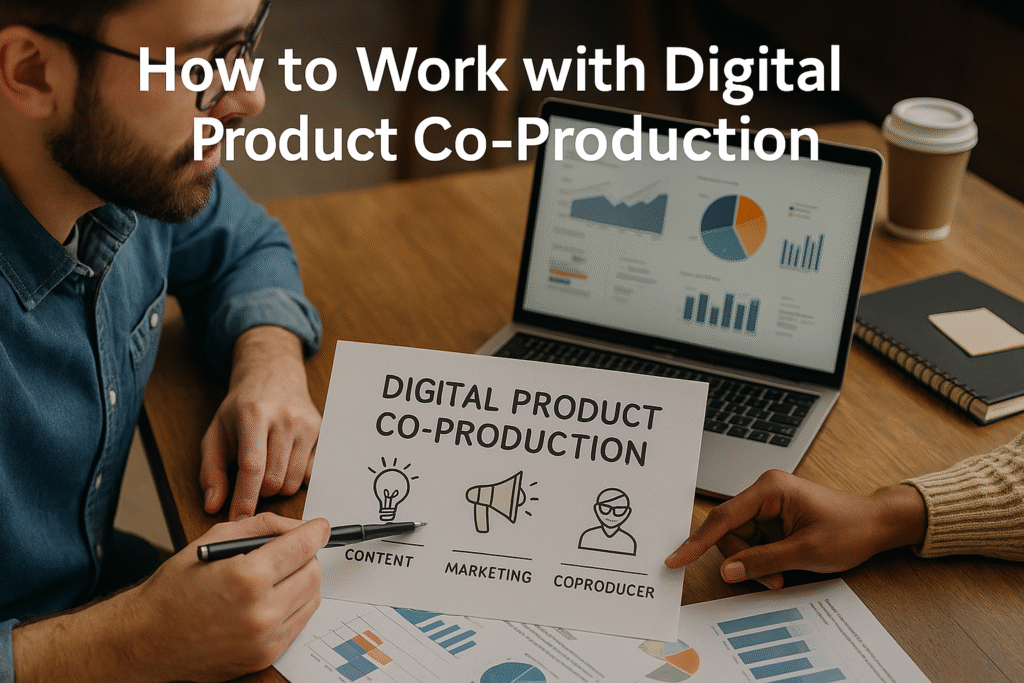Digital product co-production (or “coprodução” in Portuguese) is an increasingly popular model where two or more people collaborate to create, launch, and sell online products—like courses, ebooks, or memberships.
In this model, each person brings a specific skill set to the table: one might be the expert or content creator, while the other handles marketing, strategy, or tech implementation.
Whether you’re the creator or the co-producer, this article will teach you how to enter this world strategically and profitably.
What Is Digital Product Co-Production?
Co-production involves strategic collaboration to bring a digital product to life. Usually, one person is the expert—someone with valuable knowledge or experience. The other is the coproducer, who knows how to transform that knowledge into a profitable online business.
Think of it as the expert being the “voice,” and the coproducer being the “engine” behind the scenes.
Typical co-production roles:
- Expert: Teaches or creates the content
- Coproducer: Handles strategy, launches, tech, and marketing
This is different from partnerships where both parties split every responsibility equally. In co-production, each person sticks to their strength.
Why Co-Production Works
Some creators have excellent content but no idea how to market or scale it. On the other hand, many marketers know how to sell but lack a unique product to offer.
Co-production solves both problems and allows both sides to grow faster—together.
Main benefits:
- Faster results: Two minds working in harmony beat one
- Leverage: You focus only on what you’re good at
- Lower upfront cost: Especially for the expert, since the coproducer invests in time, tools, and sometimes even ad budget
- Shared risk and responsibility
It’s a win-win, as long as expectations are clearly aligned.
Who Should Consider Becoming a Coproducer?
You’re a great fit for digital co-production if you:
- Understand digital marketing (funnels, email, copywriting, ads)
- Know how to structure online courses or digital products
- Are organized and can manage projects and deadlines
- Like working behind the scenes
- Enjoy building and launching brands that aren’t necessarily your own
Coproducers often act as business developers or launch managers. You don’t need to be a coder or a guru—but you must understand the digital business game.
How to Find Experts or Content Creators to Partner With
A successful coproducer knows how to spot high-potential talent. The best creators usually:
- Have real-world experience or proven knowledge
- Already have a small audience or reputation
- Are open to collaboration but lack marketing know-how
Where to find them:
- LinkedIn and Instagram (experts posting niche content)
- YouTube creators in growing niches
- Online communities (Facebook Groups, Discord)
- Events or summits in specific industries
- Referrals from other producers or marketers
Start conversations by offering value and showing you understand their content and how to monetize it.
Key Elements of a Successful Co-Production Deal
Before starting, define all the responsibilities, rights, and revenue splits.
Important questions to address:
- What does each person bring to the table?
- How will profits be divided (usually 50/50, but it depends)?
- Who owns the content and branding?
- Who manages the client data and email list?
- How long will the partnership last?
- What happens if one side wants to leave?
Put everything in writing. A simple contract or partnership agreement avoids confusion or conflict later.
Tools You’ll Likely Use as a Coproducer
Being organized and tech-savvy is crucial. These tools are commonly used in digital product co-production:
- Email Marketing: ConvertKit, MailerLite, ActiveCampaign
- Landing Pages: LeadPages, Systeme.io, ClickFunnels
- Course Platforms: Hotmart, Eduzz, HeroSpark, Teachable
- Project Management: Trello, Asana, Notion
- File Sharing & Docs: Google Drive, Canva, Loom
- Automation: Zapier, Make.com
You don’t need to master every tool—just enough to keep the product flow smooth and professional.
Launching the First Product Together
Start simple. Don’t aim for a huge launch before validating the market.
Steps to a first launch:
- Build the audience – Use email, social media, or free content
- Create a lead magnet – A freebie to capture interest (e.g., ebook, checklist)
- Warm up the list – Deliver value before selling anything
- Create the MVP (Minimum Viable Product) – A simple but complete version of the product
- Launch – Through email, social media, and optionally paid ads
- Collect feedback and testimonials – To improve and scale
Repeat the process, improve the system, and gradually build authority and revenue.
How to Avoid Common Mistakes
Co-production can be a dream—or a disaster—depending on how it’s managed.
Watch out for:
- Lack of clear agreement: Define every role and expectation in writing
- Choosing the wrong partner: Align values, goals, and communication styles
- Trying to launch too fast: Focus on testing and quality over speed
- Doing everything manually: Automate and delegate where possible
- Not understanding your audience: Research and test before building
The best partnerships are built on transparency, mutual respect, and long-term thinking.
Final Thoughts: Is Co-Production Right for You?
Co-producing digital products can be one of the most lucrative and flexible ways to build a business. If you’re someone who enjoys strategy, systems, and execution—and you like helping others shine—it might be your perfect path.
You don’t need to be famous. You don’t need your own big brand. You just need skills, clarity, and a desire to build something meaningful—together.
Start small. Start smart. And grow with the right people.

